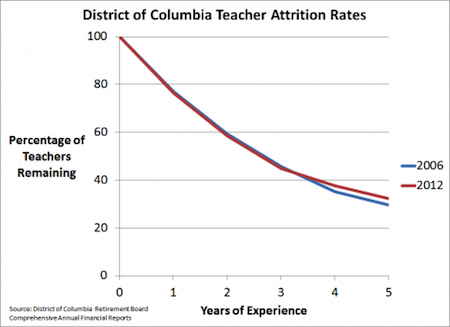If you follow news about the District of Columbia Public Schools (DCPS) closely, you could be forgiven if you thought teacher turnover had increased since the schools were handed over to mayoral control in 2007. But, at least according to the city’s teacher pension plan, turnover hasn’t increased at all; it’s actually declined slightly.
Since 2007, DCPS leaders Michelle Rhee and Kaya Henderson have led controversial reforms like a new evaluation system, a comprehensive pay-for-performance plan, and school closures. They’ve used the new evaluation system ratings and school closures to lay off or fire hundreds of teachers each of the last several years. Meanwhile, media outlets like the Washington Post have run numerous stories highlighting high teacher turnover rates. Just last month, Mayor Vincent Gray was assailed for the “untenably” high teacher turnover rates.
By all accounts, DCPS does have high turnover rates. But that does not prove they’ve risen due to recent policies. According to the District of Columbia Retirement Board, retention rates have barely budged at all since 2006. The DCRB administers retirement benefits for 4,500 active plan members, including all permanent, temporary, part-time, and probationary teachers. According to the Common Core of Data, DCPS employed nearly 3,800 teachers in 2010-11, so even though the retirement system also includes other classes of workers employed by DCPS (certain public charter school employees are also eligible to be participants), the vast majority of DCRB’s members appear to be DCPS teachers.
Each year, DCRB issues a Comprehensive Annual Financial Report. In order to estimate how many teachers will vest and become eligible for a pension, DCRB uses “withdrawal” tables to estimate how many teachers will leave in a given year. These estimates are typically based on actual turnover rates, and they are used to determine how well the plan is funded and how much money it needs to contribute each year. The graph below looks at DCRB’s withdrawal assumptions for 25-year-old teachers beginning their employment in 2006 and 2012. Both lines have relatively steep drop-offs for the first three years but then begin to flatten out somewhat. Notice that there’s almost no distance between the 2006 and the 2012 lines. That’s because DCRB assumes that teacher turnover rates have stayed nearly the exact same over the last six years. Either DCRB is wrong and they’re ignoring whatever rise that Rhee and Henderson’s policies have caused, or DCRB is right and the rest of us need to check our assumptions.

This graph does provide another piece of evidence confirming that teacher turnover is very high in DCPS schools. According to these estimates, only about 30 percent of new teachers will stay in DCPS schools for five years. The rest will leave. That’s a problem for the district and schools as they deal with finding and training replacements, let alone the parents and students at schools that are forced to deal with instability.
When discussing teacher retention, we often focus on the consequences for districts, schools, and students, but we almost never talk about the consequences for individual teachers. That’s unfortunate, because the penalties are steep and they affect a large number of people. In DCPS, the 70 percent of teachers who do not reach five years of service will not be eligible for a retirement benefit. They can receive a refund of their own contributions, with no interest, but they are not entitled to any contributions their employer had made on their behalf. That policy will disadvantage huge numbers of DCPS teachers and endangers their retirement security.
Ultimately, it’s important to have these sorts of nuanced discussions about teacher retention. We should consider the overall rate, look for any recent trends and try to identify causes, and acknowledge that the consequences for high turnover affect everyone involved–parents, students, employers, and even the departing teacher.
—Chad Aldeman
This post originally appeared at TeacherPensions.org.


